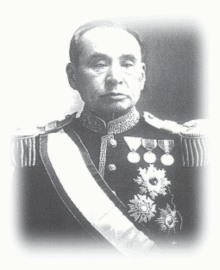Yamao Yōzō
| Yamao Yōzō | |
|---|---|
 Viscount Yamao Yōzō | |
| Born |
November 5, 1837 Yamaguchi, Japan |
| Died |
December 21, 1917 (aged 80) Tokyo, Japan |
| Nationality | Japan |
| Occupation | Engineer, Educator, Politician |
Viscount Yamao Yōzō (山尾 庸三, November 5, 1837 – December 21, 1917) was a Japanese samurai of the late Edo period who became an influential member of the Meiji era government of Japan.
Early life
Yamao was born in Aio-Futajima, a village in Chōshū domain (present day Yamaguchi city Yamaguchi prefecture), and had received the traditional training of a samurai at a private school in Edo. Together with Itō Hirobumi, he was a member of the Chōshū Five, smuggled out of Nagasaki in 1863 against the national seclusion laws of the Tokugawa bakufu to study in Great Britain.
Study in Scotland
Before being able to study at the University College London, the members of the Choshu Five studied English for a year. Two of his colleagues Itō Hirobumi and Inoue Kaoru returned to Japan to try and stop Chōshū domain going to war with the Western powers, but Yamao and two other remained and studied science and industry at University College London. After two years Yamao went to live in Glasgow between 1866 and 1868. During this period he lived in the home of Colin Brown, and worked at Napier's shipyard on the Clyde. At the same time he attended evening classes at Anderson's College (now the University of Strathclyde) together with Henry Dyer, although they did not become personally acquainted.[1]
Return to Japan
After returning to Japan after the Meiji Restoration, Yamao joined the new Meiji government and was for a while in charge of the Yokohama Shipyards (later part of Ishikawajima-Harima Heavy Industries). By the time Henry Dyer reached Japan in 1873, Yamao was Acting Vice Minister of Public Works and as such was responsible for setting up the Imperial College of Engineering as well as the Imperial College of Art, and Kobu Daigakkō, which later became the Department of Technology at Tokyo Imperial University-and served as President of the Japan Engineering Society for 36 years. He also set up a school for the blind and deaf and is said to have introduced the idea of sign language to Japan.
Yamao assumed the office of rector of the Imperial College of Engineering and was a strong advocate of the need for technical education to support the industrialization of Japan. Henry Dyer and Yamao had an extremely good relationship during this period, strengthened by the bond of their common background.
Yamao was elevated to the rank of shishaku (viscount) in the kazoku peerage system.
Auld Lang Syne
It has been claimed that Yamao introduced the well known Scottish song Auld Lang Syne to Japan where it is called Hotaru no Hikari (The Light of the Fireflies) and is sung at high school graduation ceremonies.
Reference and further reading
- ↑ Dyer, Henry (2002). Dai Nippon, the Britain of the East: A study in national evolution. Adamant Media Corporation. ISBN 978-1-4021-8920-3.
- Beasley, W. G. The Meiji Restoration. Stanford: Stanford University Press, 1972.
- Cobbing, Andrew. The Japanese Discovery of Victorian Britain. RoutledgeCurzon, London, 1998. ISBN 1-873410-81-6
- Craig, Albert M. Chōshū in the Meiji Restoration. Cambridge: Harvard University Press, 1961.